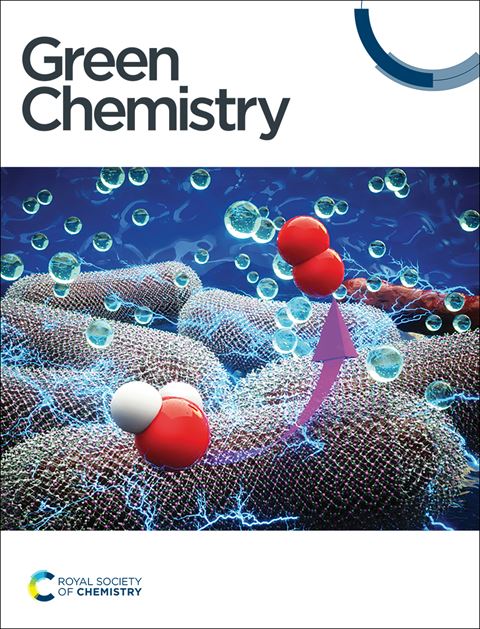Tandem chemical hydrolysis and bioelectrochemical upcycling of waste polyethylene terephthalate (PET) for sustainable biobutanol and ethanol production ensuring plastics circularity†
IF 9.2
1区 化学
Q1 CHEMISTRY, MULTIDISCIPLINARY
引用次数: 0
Abstract
To establish a sustainable plastic system, it is crucial to implement effective recycling and upcycling strategies that circulate the materials within the market and prevent them from entering the ecosystems. Polyethylene terephthalate (PET), which is the most widely used fossil-derived synthetic polyester, is usually disposed as waste. Development of novel chemical upcycling technologies that can transform plastic wastes into economically viable chemicals is crucial to establish a circular plastics economy. This study delineated a methodology to combine mild chemical pretreatment and biocatalysts via bio-electrofermentation for the conversion of waste PET to sustainable biofuel blendstocks. Initially, PET was depolymerised to its monomers using an alkali catalyst (>98% conversion efficiency), and their structural characteristics were confirmed using FT-IR, NMR (1H and 13C), TGA, FESEM, XRD and XPS techniques. Furthermore, co-culturing with Klebsiella sp. and Clostridium sp. showed positive result towards TPA degradation (55%–74%) with various applied poised potentials to yield high-value bio-fuels. The electrochemical analysis highlighted the role of applied potential in the bioelectrochemical system (BES), where the +0.8 V condition consistently demonstrated a better performance across all metrics, including electron flux, substrate conversion, and product yield. The maximum yield were found to be 0.31 g L−1 for butanol and 0.23 g L−1 for ethanol at +0.8 V in the BES. On the other hand, the life cycle assessment (LCA) methodology was employed to understand the environmental footprints of the studied upcycling process, and it showed a global warming potential of 1.13 ton CO2 eq. per ton biofuel. While, recycling PET accounted for 1.96 ton CO2 eq. and 3.06 ton CO2 eq. from the ideal PET production process. Alternatively, other chemical and enzymatic PET upcycling processes had 3–7 times higher impacts. Therefore, the present work paves a new way for the upcycling of PET and makes a significant contribution to the development of a circular plastics economy.

废弃聚对苯二甲酸乙二醇酯(PET)的串联化学水解和生物电化学升级回收,用于可持续的生物丁醇和乙醇生产,确保塑料循环†
为了建立一个可持续的塑料系统,至关重要的是实施有效的回收和升级回收战略,使材料在市场内流通,防止它们进入生态系统。聚对苯二甲酸乙二醇酯(PET)是使用最广泛的化石合成聚酯,通常作为废物处理。开发新的化学品升级回收技术,将塑料废物转化为经济上可行的化学品,对于建立循环塑料经济至关重要。本研究描述了一种结合温和化学预处理和生物催化剂的方法,通过生物电发酵将废弃PET转化为可持续的生物燃料混合物。首先,使用碱催化剂将PET解聚为单体(转化率>;98%),并使用FT-IR, NMR (1H和13C), TGA, FESEM, XRD和XPS技术确认其结构特征。此外,与克雷伯氏菌和梭状芽胞杆菌共培养对TPA降解(55%-74%)有积极的效果,具有生产高价值生物燃料的各种应用潜力。电化学分析强调了应用电位在生物电化学系统(BES)中的作用,其中+0.8 V条件在所有指标上都表现出更好的性能,包括电子通量、衬底转化率和产品收率。在+0.8 V条件下,丁醇和乙醇的最大产率分别为0.31 g L−1和0.23 g L−1。另一方面,利用生命周期评价(LCA)方法了解了所研究的生物燃料升级循环过程的环境足迹,表明每吨生物燃料产生1.13吨二氧化碳当量的全球变暖潜势。而在理想的PET生产过程中,回收PET分别产生1.96吨CO2当量和3.06吨CO2当量。相反,其他化学和酶促PET升级回收过程的影响要高出3-7倍。因此,本研究为PET的升级利用开辟了一条新的途径,为发展循环塑料经济做出了重要贡献。
本文章由计算机程序翻译,如有差异,请以英文原文为准。
求助全文
约1分钟内获得全文
求助全文
来源期刊

Green Chemistry
化学-化学综合
CiteScore
16.10
自引率
7.10%
发文量
677
审稿时长
1.4 months
期刊介绍:
Green Chemistry is a journal that provides a unique forum for the publication of innovative research on the development of alternative green and sustainable technologies. The scope of Green Chemistry is based on the definition proposed by Anastas and Warner (Green Chemistry: Theory and Practice, P T Anastas and J C Warner, Oxford University Press, Oxford, 1998), which defines green chemistry as the utilisation of a set of principles that reduces or eliminates the use or generation of hazardous substances in the design, manufacture and application of chemical products. Green Chemistry aims to reduce the environmental impact of the chemical enterprise by developing a technology base that is inherently non-toxic to living things and the environment. The journal welcomes submissions on all aspects of research relating to this endeavor and publishes original and significant cutting-edge research that is likely to be of wide general appeal. For a work to be published, it must present a significant advance in green chemistry, including a comparison with existing methods and a demonstration of advantages over those methods.
 求助内容:
求助内容: 应助结果提醒方式:
应助结果提醒方式:


